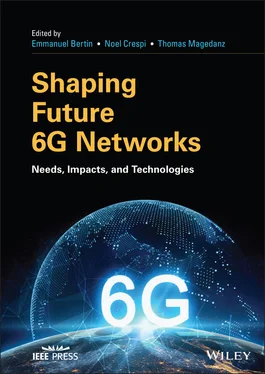Shaping Future 6G Networks
Здесь есть возможность читать онлайн «Shaping Future 6G Networks» — ознакомительный отрывок электронной книги совершенно бесплатно, а после прочтения отрывка купить полную версию. В некоторых случаях можно слушать аудио, скачать через торрент в формате fb2 и присутствует краткое содержание. Жанр: unrecognised, на английском языке. Описание произведения, (предисловие) а так же отзывы посетителей доступны на портале библиотеки ЛибКат.
- Название:Shaping Future 6G Networks
- Автор:
- Жанр:
- Год:неизвестен
- ISBN:нет данных
- Рейтинг книги:3 / 5. Голосов: 1
-
Избранное:Добавить в избранное
- Отзывы:
-
Ваша оценка:
- 60
- 1
- 2
- 3
- 4
- 5
Shaping Future 6G Networks: краткое содержание, описание и аннотация
Предлагаем к чтению аннотацию, описание, краткое содержание или предисловие (зависит от того, что написал сам автор книги «Shaping Future 6G Networks»). Если вы не нашли необходимую информацию о книге — напишите в комментариях, мы постараемся отыскать её.
Discover the societal and technology drivers contributing to build the next generation of wireless telecommunication networks Shaping Future 6G Networks: Needs, Impacts, and Technologies
Shaping Future 6G Networks
Shaping Future 6G Networks — читать онлайн ознакомительный отрывок
Ниже представлен текст книги, разбитый по страницам. Система сохранения места последней прочитанной страницы, позволяет с удобством читать онлайн бесплатно книгу «Shaping Future 6G Networks», без необходимости каждый раз заново искать на чём Вы остановились. Поставьте закладку, и сможете в любой момент перейти на страницу, на которой закончили чтение.
Интервал:
Закладка:
Therefore, there is a case for further developing promising 5G innovations and bringing them to full fruition in 6G networks, focusing on reliability and coverage, with possible improvements in throughput and latency. Notably, the integration of non‐terrestrial (e.g. with satellites, balloons, and unmanned aerial vehicles (UAVs) and terrestrial networks in 6G will increase the coverage of the network, allowing connectivity of a staggering 10 7devices per square kilometer. PS communications will also benefit from the increased throughput, to provide teleportation‐like experience between the command station and the incident site. Moreover, orchestration and remote control of robots requires end‐to‐end ultralow latency, thus pushing the over‐the‐air latency requirement into the sub‐milliseconds region and placing tight constraints on the latency budget of the rest of the network. An important requirement of PS networking is related to the sustainability and autonomy of the infrastructure, which should strive to consume as little power as possible to improve battery life in off‐grid infrastructures and mobile devices. To this end, 6G is expected to increase the energy efficiency by a factor of 10 with respect to 5G, with improvements in both the device battery lifetime and the overall network consumption.
2.3.6 Health and Well‐being
The global increase in the cost of providing healthcare services to a continuously ageing and growing population is rapidly becoming unsustainable. In this context, 6G is positioned to foster the healthcare revolution by eliminating time and space barriers through telemedicine, achieving healthcare workflow optimizations, and guaranteeing patient access to increasingly more efficient and affordable health assistance.
On one side, 6G connectivity solutions should enable the transition from a traditional provider–patient relationship toward a “care outside hospital” paradigm, where primary care services will be delivered by health professionals directly to the patients at home. Moving care outside clinics and health facilities will not only promote more individualized and personalized assistance but also empower preventive care while avoiding that fragile patients with limited mobility capabilities need to travel. From a business‐oriented perspective, home care guarantees the most efficient use of healthcare resources (e.g. preventive care can drastically reduce the need for expensive treatments for patients with chronic conditions) and a significant reduction of management and administration costs for institutional care centers [7].
Cost savings in the healthcare industry will also increase the reach and accessibility to healthcare assistance to the most unprivileged and least developed countries in the world, thus making it possible for an estimated billion extra patients globally to receive quality treatment [8]. The goal is to achieve healthier life years and more efficient health and social care for a larger population [8, pp. 5–6].
Moreover, the development of 6G technologies, together with the digitalization of healthcare services, will allow more granular and higher quality data to be collected on patients, thereby improving clinical analyses and reducing health costs associated with treatments of diseases.
Furthermore, 6G innovations should drive the design and adoption of new use cases in the healthcare sector. VR‐ and AR‐based technologies will facilitate remote patient monitoring, while artificial intelligence and tactile sensing will enable even more invasive healthcare assistance through robotic telesurgery, i.e. remote surgery where surgeon and patient are geographically separated. Robotics and automation advancements will empower connected ambulances, while holographic solutions combined with the transmission of important health indicators (collected through wireless body sensors) will make it possible to improve healthcare assistance via virtual patient consultation and monitoring.
Due to technology limitations in today’s wireless networks, future healthcare applications are calling for the design of new wireless communication systems that support continuous interaction with mobile end users. Besides the high cost and the lack of medical professionals and infrastructures in today’s healthcare industry, the current major limitation is the lack of real‐time tactile feedback. Moreover, the explosion of advanced eHealth and mobile Health (mHealth) services challenges the ability to meet their stringent QoS requirements. For reliable remote surgery, for example, the latency demands will be in the order of sub‐milliseconds, which are not yet achievable with upcoming 5G innovations. Even for less latency‐critical use cases, e.g., digital healthcare assistance enabled through VR/AR technologies, combined with holographic communication, will pose very strict requirements in terms of end‐to‐end throughput will need to be satisfied (for 3D MediVision products, a resolution of 1920 × 1080 pixel and a frame rate of 120 fps for 3D displays will require multi‐Gbps data rates to be supported [9]). Extremely high reliability (>99.99999%) will also be needed due to the potentially catastrophic consequences of a communication failure. It is estimated that the increased spectrum availability, combined with the refined intelligence of 6G networks, will guarantee these KPIs, together with 5–10× gains in spectral efficiency [1].
In this context, integrating networks and applications emerges as a viable approach to support resource‐demanding services by exchanging information in such a way that specific requirements are satisfied. For example, different network configurations and related system parameters (including – but not limited to – the choice about the optimal deployment, power allocation, interface selection) should be adopted based on network’s available resources and supported capabilities and dynamically (and iteratively) updated until network requirements are satisfied.
2.3.7 Smart‐X IoT
The IoT and smart city paradigms have emerged as typical use cases for 4G and 5G networks, as well as for a wide set of noncellular communication technologies (e.g. LoRaWAN, LP‐WAN, among others). 6G will further expand these platforms, to ease the transition toward digital services in a wide range of business areas. Notably, Smart‐X (where X refers to everything) use cases will require ubiquitous coverage, with a support for more than 10 7connected devices per square kilometer, and high energy efficiency, so that zero‐energy devices can be globally deployed to gather environmental awareness, track complex processes (e.g. shipments, production lines), and then actuate data‐driven policies. Future Smart‐X scenarios will heavily rely on artificial intelligence and machine learning techniques to infer trends and behaviors, which will need to be driven by a constant stream of data from the network.
An area in which the importance of connectivity‐based digital services is central is that of agriculture and farming. A sensor‐enabled data pipeline is key to monitor the efficiency and results obtained when growing crop in very large areas. Moreover, the availability of data in this area makes it possible to track the evolution of terrain needs and characteristics and infer future trends in crop availability. Similarly, for animal breeding, connectivity‐based approaches allow farmers to monitor the position and health status of each single animal in the herd.
Data‐driven predictive analytics and monitoring are useful also for fleet management, as discussed in Section 2.3.4, and for smart warehouse management. In particular, with Smart‐X approaches, the status, position, and value of goods can be tracked with cheap sensors from the source (e.g. the factory in which the good is manufactured) to the warehouse in which it is stocked and, eventually, to the final destination. Moreover, for products such as home appliances, industrial machines, and robots, among others, embedded zero‐energy sensors can measure and report failures or anomalous behaviors toward an integrated factory‐to‐customer assistance and maintenance pipeline.
Читать дальшеИнтервал:
Закладка:
Похожие книги на «Shaping Future 6G Networks»
Представляем Вашему вниманию похожие книги на «Shaping Future 6G Networks» списком для выбора. Мы отобрали схожую по названию и смыслу литературу в надежде предоставить читателям больше вариантов отыскать новые, интересные, ещё непрочитанные произведения.
Обсуждение, отзывы о книге «Shaping Future 6G Networks» и просто собственные мнения читателей. Оставьте ваши комментарии, напишите, что Вы думаете о произведении, его смысле или главных героях. Укажите что конкретно понравилось, а что нет, и почему Вы так считаете.












